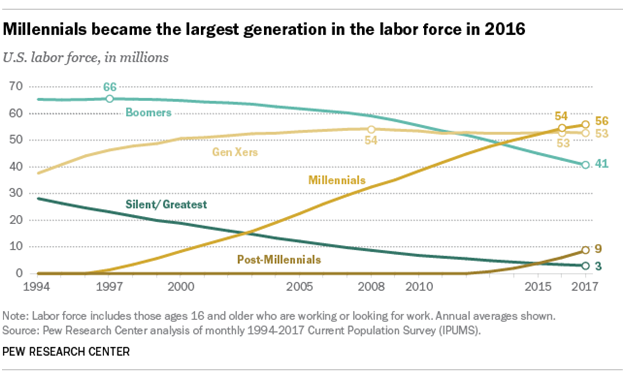![[Source: Pew Research Center ]](https://fabbaloo.com/wp-content/uploads/2020/05/Millennials_img_5eb09468d9af2.png)
Charles Goulding and Andressa Bonafe of R&D Tax Savers discuss generational impact of 3D printing demographics.
In 2019, millennials will become the largest population group in the U.S. As members of the first truly digital generation approach their prime income years, their impact on business decision-making should reach unprecendented levels. Tech-savvy millennials are the largest users of 3D printing, a technology that should be at the core of their innovative approach to design and production.
Millennials Take Over the Market
According to Pew Research Center, millennials — loosely defined as those born between 1981 and 1996 — became the largest generation in the labor force in 2016, representing over one-third of those who are working or looking for work. Baby boomers, who have long held leadership positions in both private and public sectors, are now moving towards retirement and opening the way for their younger counterparts to take over.
Reaching Peak Income
According to another Pew Research Center report, young adult households currently make more money than most older Americans did at the same age. With the eldest millennials soon to turn 40, they approach the age groups of highest average income, which will translate into an even greater impact on the U.S. market. According to Accenture, millennials will spend $1.4 trillion annually by 2020, representing nearly one-third of total retail sales in the country.
![[Source: The Wall Street Journal ]](https://fabbaloo.com/wp-content/uploads/2020/05/Millennials2_img_5eb0946935a9f.png)
Navigating the Information Age
Having grown up with technology, millennials bring to the table a valuable set of skills to navigate the information age. Overall, they are especially qualified for generating innovation — as featured in a recent Industry Week article, experts point out that millennials are more prone to taking risks, exploring new skills and opportunities, and adopting new ideas. Not surprisingly, they are expected to challenge many of the established practices of design and production. For instance, the integration of Internet of Things and other data-driven technologies promise to improve operations and transform supply chains.
Millennials and 3D Printing
Additive manufacturing is poised to be a key aspect of the millennial-led market. In Sculpteo’s 2019 The State of 3D Printing survey, 80% of companies said that their speed of innovation has been significantly improved by 3D printing. Perhaps unsurprisingly, the research also verified that millennials are the most common users of 3D printing, with over 39% of respondents between 25 and 34 (and more than 60% between 25 and 44).
In addition to enabling significant process improvements, 3D printing is an invaluable tool for unique and customized work, which is often at the core of this generation’s quest for uniqueness and authenticity. Millennials innovative approach and skillset should also allow for a refinement of existing 3D printing capabilities, including enhanced dimensional precision and software functionalities.
The Research & Development Tax Credit
Enacted in 1981, the now permanent Federal Research and Development (R&D) Tax Credit allows a credit that typically ranges from 4%-7% of eligible spending for new and improved products and processes. Qualified research must meet the following four criteria:
-
Must be technological in nature
-
Must be a component of the taxpayer’s business
-
Must represent R&D in the experimental sense and generally includes all such costs related to the development or improvement of a product or process
-
Must eliminate uncertainty through a process of experimentation that considers one or more alternatives
Eligible costs include US employee wages, cost of supplies consumed in the R&D process, cost of pre-production testing, US contract research expenses, and certain costs associated with developing a patent.
On December 18, 2015, President Obama signed the PATH Act, making the R&D Tax Credit permanent. Since 2016, the R&D credit has been used to offset Alternative Minimum Tax (AMT) for companies with revenue below $50MM and, startup businesses can obtain up to $250,000 per year in payroll tax cash rebates.
Conclusion
An ongoing change in demographics will bring millennials to center of the U.S. economy. As tech-savvy professionals reach their prime income years, investment and usage of 3D printing should expand, becoming the basis for a renewed approach to innovation. Additive manufacturing companies should take advantage of R&D tax credits to support their efforts to meet the growing millennial demand.











